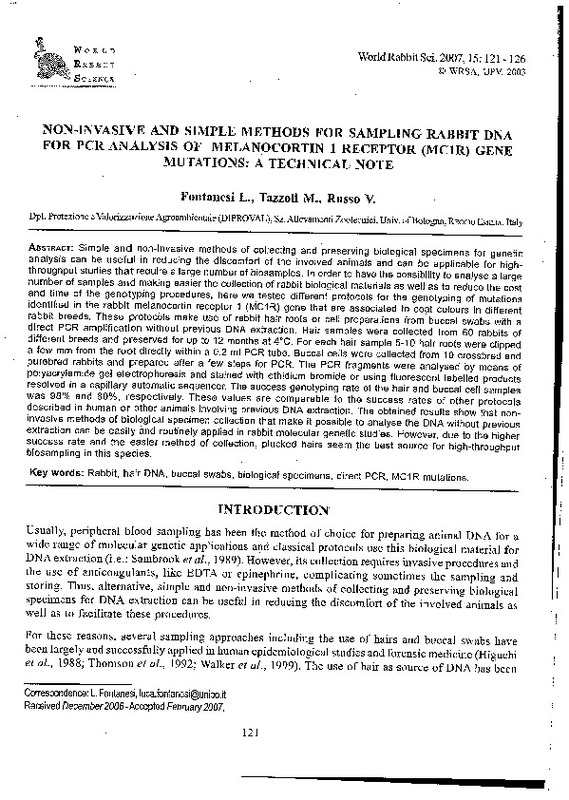JavaScript is disabled for your browser. Some features of this site may not work without it.
Buscar en RiuNet
Listar
Mi cuenta
Estadísticas
Ayuda RiuNet
Admin. UPV
Non-invasive and simple methods for sampling rabbit DNA for PCR analysis of melanocortin 1 receptor (MC1R) gene mutations: a technical note
Mostrar el registro sencillo del ítem
Ficheros en el ítem
| dc.contributor.author | Fontanesi, L.
|
|
| dc.contributor.author | Tazzoli, M.
|
|
| dc.contributor.author | Russo, V.
|
|
| dc.date.accessioned | 2011-02-08T10:55:50Z | |
| dc.date.available | 2011-02-08T10:55:50Z | |
| dc.date.issued | 2007 | |
| dc.identifier.issn | 1257-5011 | |
| dc.identifier.uri | http://hdl.handle.net/10251/9480 | |
| dc.description.abstract | [EN] Simple and non-invasive methods of collecting and preserving biological specimens for genetic analysis can be useful in reducing the discomfort of the involved animals and can be applicable for highthroughput studies that require a large number of biosamples. In order to have the possibility to analyse a large number of samples and making easier the collection of rabbit biological materials as well as to reduce the cost and time of the genotyping procedures, here we tested different protocols for the genotyping of mutations identified in the rabbit melanocortin receptor 1 (MC1R) gene that are associated to coat colours in different rabbit breeds. These protocols make use of rabbit hair roots or cell preparations from buccal swabs with a direct PCR amplification without previous DNA extraction. Hair samples were collected from 60 rabbits of different breeds and preserved for up to 12 months at 4°C. For each hair sample 5-10 hair roots were clipped a few mm from the root directly within a 0.2 ml PCR tube. Buccal cells were collected from 10 crossbred and purebred rabbits and prepared after a few steps for PCR. The PCR fragments were analysed by means of polyacrylamide gel electrophoresis and stained with ethidium bromide or using fluorescent labelled products resolved in a capillary automatic sequencer. The success genotyping rate of the hair and buccal cell samples was 98% and 80%, respectively. These values are comparable to the success rates of other protocols described in human or other animals involving previous DNA extraction. The obtained results show that noninvasive methods of biological specimen collection that make it possible to analyse the DNA without previous extraction can be easily and routinely applied in rabbit molecular genetic studies. However, due to the higher success rate and the easier method of collection, plucked hairs seem the best source for high-throughput biosampling in this species. | es_ES |
| dc.description.sponsorship | This work was supported by RFO funds from the University of Bologna. We thank several rabbit breeders and Associazione Nazionale Coniglicoltori Italiani (ANCI) for their collaboration in the sampling of biological materials | |
| dc.language | Inglés | es_ES |
| dc.publisher | World Rabbit Science. ICTA. UPV | es_ES |
| dc.relation.ispartof | World Rabbit Science | |
| dc.rights | Reserva de todos los derechos | es_ES |
| dc.subject | Rabbit | es_ES |
| dc.subject | Hair dna | es_ES |
| dc.subject | Buccal swabs | es_ES |
| dc.subject | Biological specimens | es_ES |
| dc.subject | Direct pcr | es_ES |
| dc.subject | Mc1r mutations | es_ES |
| dc.title | Non-invasive and simple methods for sampling rabbit DNA for PCR analysis of melanocortin 1 receptor (MC1R) gene mutations: a technical note | es_ES |
| dc.type | Artículo | es_ES |
| dc.date.updated | 2011-02-08T10:10:53Z | |
| dc.identifier.doi | 10.4995/wrs.2007.598 | |
| dc.rights.accessRights | Abierto | es_ES |
| dc.description.bibliographicCitation | Fontanesi, L.; Tazzoli, M.; Russo, V. (2007). Non-invasive and simple methods for sampling rabbit DNA for PCR analysis of melanocortin 1 receptor (MC1R) gene mutations: a technical note. World Rabbit Science. 15(2). https://doi.org/10.4995/wrs.2007.598 | es_ES |
| dc.description.accrualMethod | SWORD | es_ES |
| dc.relation.publisherversion | https://doi.org/10.4995/wrs.2007.598 | |
| dc.description.volume | 15 | |
| dc.description.issue | 2 | |
| dc.identifier.eissn | 1989-8886 | es_ES |
| dc.contributor.funder | Università di Bologna |








